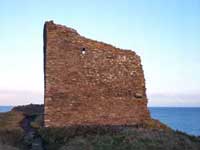 After the Vikings the Earls of Orkney held Orkney from the King of Norway and the area now called Caithness and Sutherland from the King of Scotland. Under them many of the earliest castles in Caithness were built. The architect of these early Norse castles was closely allied to that of their Norman cousins, although often smaller. During the 12th and 13th centuries the Kings of Scotland made determined, and ultimately successful, efforts to extend their authority to the northern mainland. By the time of Alexander III (1249-86) Caithness, although still linked with the Norse earldom of Orkney, could be considered an integral part of the Scottish Kingdom. Families of Anglo-Norman descent acquired land including the Sinclairs, later Earls of Caithness. They too built castles.
After the Vikings the Earls of Orkney held Orkney from the King of Norway and the area now called Caithness and Sutherland from the King of Scotland. Under them many of the earliest castles in Caithness were built. The architect of these early Norse castles was closely allied to that of their Norman cousins, although often smaller. During the 12th and 13th centuries the Kings of Scotland made determined, and ultimately successful, efforts to extend their authority to the northern mainland. By the time of Alexander III (1249-86) Caithness, although still linked with the Norse earldom of Orkney, could be considered an integral part of the Scottish Kingdom. Families of Anglo-Norman descent acquired land including the Sinclairs, later Earls of Caithness. They too built castles.
Castles were often built on peninsulas, either jutting out into the sea or formed by two parallel inlets. Many castles were many storeys high with thick walls. Often the remaining part of the peninsula was taken up with outbuildings. The castle of Oldwick, is one of the earliest stone built strongholds in Scotland and Castle Sinclair-Girnigoe one of the finest. As times became more peaceful the earlier fortified castles were either abandoned for new laird’s houses inland or transformed into baronial mansions, like the Castle of Mey.